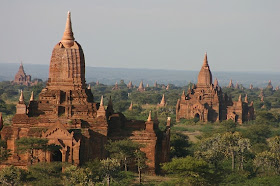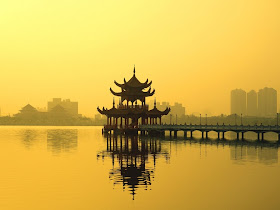Bagan is a plain that covers an area of about 16 squares miles alongside the Ayeyarwaddy’s east bank. The temples and Pagodas of Bagan that are now decaying were constructed mainly between the 11th and 13th centuries A.D., which was during the time that Bagan was the Myanmar dynasty seat. Local chronicles have carried tradition that says that 55 kings ruled over the Bagan kingdom over twelve centuries.
The Bagan temples are known as “gu” and were inspiration from the Buddhist rock caves. These were big multi-story buildings that the people could enter and were places where people went to worship, with the interior having richly frescoed corridors and sacred images and shrines that would be worshiped. The temples are often massively built oblong or square structures with terraces on the outside to represent Mount Meru, which was a symbolic home for the gods. The Bagan temples would also be surrounded by a wall made to be thick so that it would separate the sacred realm from the world outside.
The pagodas of Bagan are funerary monuments that have acquired a Buddhism cosmic symbolism. The Bagan pagodas also contain relics that are associated with Buddha. Some of the monuments were constructed in honor of a notable person, being built to bring lasting memories for important families as well. These structures are built in the shape of a bell that is set on an octagonal or square base, and they usually stand to a tapering peak covered with jewels and metal, with a sacred decoration shaped like a parasol (called “hti”) on the top.
Name of the few Bagan temples:
Ananda Temple- This temple was completed in 1091 A.D. by King Kyanzittha. It is modeled after the legendary Nandamula cave in the Himalaya mountains. Soaring to 51 meters, it received its golden gilding in 1990 in commemeration of the 900th anniversary of its construction. Contained within the temple are four great statues of the Buddhas of the four ages. Kakusandha faces north, Konagamana faces east, Kassapa faces south, and Guatama, the most recent Buddha, faces west.
Gawdawpalin, built in the 12th century by King Narapatisithu, the 60 meter temple was badly damaged in a 1975 earthquake but has been completely reconstructed.
Dhammayangyi, the largest temple in Bagan, it was built by King Narathu who reigned from 1167 to 1170.
Shwesandaw, built in 1057 by King Anawahta, the stupa enshrines hairs of the Buddha. It is sometimes called the Ganesh Temple after the elephant headed Hindu god whose images once stood at corners of each of the five terraces.
Mahabodhi, this temple is an exact, though smaller, replica of the famous Bodhi temple in Bodh Gaya, India (where the Buddha attained enlightenment beneath the Bodhi tree). It was built during the reign of King Nantaungmya (1210-1234) and is completely covered with niches containing seated Buddha figures.
Shwezigon, this pagoda was built as the most important reliquary shrine in Bagan. Begun by King Anawrahta and completed by King Kyanzittha in 1089, it contains several bones and hairs of the Buddha. Pilgrims from throughout Burma journey to Shwezigon each year for a great festival during the Burmese month of Nadaw, which falls in the November-December period. This festival is hugely popular because elements of pre-Buddhist Nat worship (Nats are pagan anamistic spirits) were combined with Buddhist themes in the pagoda’s construction. Shwezigon is thus a center of pilgrimage for both the archaic shamanic culture of Burma and the newer religion of Buddhism.





















































